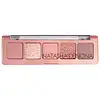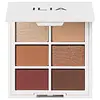What's inside
What's inside
 Key Ingredients
Key Ingredients

 Benefits
Benefits

 Concerns
Concerns

 Ingredients Side-by-side
Ingredients Side-by-side

Mica
Cosmetic ColorantCI 77891
Cosmetic ColorantZinc Stearate
Cosmetic ColorantDimethicone
EmollientOctyldodecyl Stearoyl Stearate
EmollientSynthetic Fluorphlogopite
CI 77491
Cosmetic ColorantCaprylyl Glycol
EmollientEthylhexylglycerin
Skin ConditioningCI 75470
Cosmetic ColorantTin Oxide
AbrasiveCalcium Aluminum Borosilicate
Calcium Sodium Borosilicate
Tocopherol
AntioxidantSilica
AbrasiveCI 77499
Cosmetic ColorantCI 77492
Cosmetic ColorantHdi/Trimethylol Hexyllactone Crosspolymer
Triethoxycaprylylsilane
CI 77007
Cosmetic ColorantMaltodextrin
AbsorbentAlumina
AbrasiveKaolin
AbrasiveGlycerin
HumectantTalc
AbrasiveDiisostearyl Malate
EmollientLactic Acid/Glycolic Acid Copolymer
Skin ConditioningCalcium Titanium Borosilicate
AbrasiveAluminum Calcium Sodium Silicate
Mica, CI 77891, Zinc Stearate, Dimethicone, Octyldodecyl Stearoyl Stearate, Synthetic Fluorphlogopite, CI 77491, Caprylyl Glycol, Ethylhexylglycerin, CI 75470, Tin Oxide, Calcium Aluminum Borosilicate, Calcium Sodium Borosilicate, Tocopherol, Silica, CI 77499, CI 77492, Hdi/Trimethylol Hexyllactone Crosspolymer, Triethoxycaprylylsilane, CI 77007, Maltodextrin, Alumina, Kaolin, Glycerin, Talc, Diisostearyl Malate, Lactic Acid/Glycolic Acid Copolymer, Calcium Titanium Borosilicate, Aluminum Calcium Sodium Silicate
Mica
Cosmetic ColorantAlumina
AbrasiveSynthetic Fluorphlogopite
Zinc Stearate
Cosmetic ColorantNylon-12
Butyloctyl Salicylate
Skin ConditioningCaprylic/Capric Triglyceride
MaskingEthyl Macadamiate
Skin ConditioningLonicera Caprifolium Flower Extract
PerfumingLonicera Japonica Flower Extract
Skin ConditioningTin Oxide
AbrasiveSimmondsia Chinensis Seed Oil
EmollientTocopherol
AntioxidantMalic Acid
BufferingCI 77891
Cosmetic ColorantCI 77491
Cosmetic ColorantCI 77492
Cosmetic ColorantCI 77499
Cosmetic ColorantCI 16035
Cosmetic ColorantCI 19140
Cosmetic ColorantMica, Alumina, Synthetic Fluorphlogopite, Zinc Stearate, Nylon-12, Butyloctyl Salicylate, Caprylic/Capric Triglyceride, Ethyl Macadamiate, Lonicera Caprifolium Flower Extract, Lonicera Japonica Flower Extract, Tin Oxide, Simmondsia Chinensis Seed Oil, Tocopherol, Malic Acid, CI 77891, CI 77491, CI 77492, CI 77499, CI 16035, CI 19140
Ingredients Explained
These ingredients are found in both products.
Ingredients higher up in an ingredient list are typically present in a larger amount.
Alumina is another name for the compound aluminum oxide. It is used as a thickener, absorbent, and abrasive.
As an absorbent, alumina can give a mattifying effect. It is used in mineral sunscreens to help coat nano-sized filters, such as titanium dioxide. By increasing the size of the UV filters, these ingredients stay on the skin for a longer time. By coating small sized ingredients, alumina helps thicken a product.
Alumina may be used as an abrasive, or exfoliant.
Alumina is naturally occurring in the mineral corundum. Certain varieties of corundum create rubies and sapphires. Corundum is also the crystalline form of alumina.
Learn more about AluminaCi 77491 is also hydrated iron III oxide. It's sole purpose is to give a red/pink hue to products.
Iron III oxides are classified as inorganic chemicals for coloring.
Synthetically created Ci 77491 is considered safer than those naturally found. This is because the synthetically created version may contain less impurities. Iron oxides are generally non-toxic and non-allergenic.
Learn more about CI 77491Ci 77492 is also hydrated iron III oxide. It's sole purpose is to give a yellow hue to products.
Iron III oxides are classified as inorganic chemicals for coloring.
Synthetically created Ci 77492 is considered safer than those naturally found. This is because the synthetically created version may contain less impurities. Iron oxides are generally non-toxic and non-allergenic.
Learn more about CI 77492Ci 77499 is also hydrated iron III oxide. It is created from mixing red and black iron oxides. This helps give shades of darkness to a product.
Iron III oxides are classified as inorganic chemicals for coloring.
Ci 77891 is a white pigment from Titanium dioxide. It is naturally found in minerals such as rutile and ilmenite.
It's main function is to add a white color to cosmetics. It can also be mixed with other colors to create different shades.
Ci 77891 is commonly found in sunscreens due to its ability to block UV rays.
Learn more about CI 77891Mica is a naturally occurring mineral used to add shimmer and color in cosmetics. It can also help improve the texture of a product or give it an opaque, white/silver color.
Serecite is the name for very fine but ragged grains of mica.
This ingredient is often coated with metal oxides like titanium dioxide. Trace amounts of heavy metals may be found in mica, but these metals are not harmful in our personal products.
Mica has been used since prehistoric times throughout the world. Ancient Egyptian, Indian, Greek, Roman, Aztec, and Chinese civilizations have used mica.
Learn more about MicaSynthetic Fluorphlogopite is the synthethic version of mica. It consists of fluorine, aluminum and silicate.
Synthetic Fluorphlogopite is used to add volume to products.
It is considered non-irritating on the skin.
Learn more about Synthetic FluorphlogopiteTin Oxide is an inorganic oxide used to add opacity and volume to a product. In nature, it is already found in mineral form. The main ore of tin is an opaque and shiny mineral called casseterite.
Tin Oxide helps remove translucency in a product, or make it more opaque. Besides adding opacity, tin oxide is used for bulking to add volume.
Tocopherol (also known as Vitamin E) is a common antioxidant used to help protect the skin from free-radicals and strengthen the skin barrier. It's also fat soluble - this means our skin is great at absorbing it.
Vitamin E also helps keep your natural skin lipids healthy. Your lipid skin barrier naturally consists of lipids, ceramides, and fatty acids. Vitamin E offers extra protection for your skin’s lipid barrier, keeping your skin healthy and nourished.
Another benefit is a bit of UV protection. Vitamin E helps reduce the damage caused by UVB rays. (It should not replace your sunscreen). Combining it with Vitamin C can decrease sunburned cells and hyperpigmentation after UV exposure.
You might have noticed Vitamin E + C often paired together. This is because it is great at stabilizing Vitamin C. Using the two together helps increase the effectiveness of both ingredients.
There are often claims that Vitamin E can reduce/prevent scarring, but these claims haven't been confirmed by scientific research.
Learn more about TocopherolZinc Stearate is the metal salt of stearic acid. It is a white solid used to bind, thicken, and lubricate products.
This ingredient is common in powder makeup, where it helps keep the powder together.
Zinc Stearate is hydrophobic and repels water.
This ingredient can be sourced from non-animal or animal sources. It is best to reach out to the brand to see where they source this ingredient from.
Learn more about Zinc Stearate